A Week in the Life of...a research student in New York
Muhamed Baljevic '10, has taken time out from his medical studies at WCMC-Q to do a year's research as a visiting graduate assistant in the Ansary Center for Stem Cell Therapeutics at Weill Cornell Medical College in New York. Although it is not uncommon for medical students in the U.S. to do so, Baljevic is the first WCMC-Q student to choose this path. Here's his diary for a typically busy week:
Brooklyn/New York
Monday
6:30 a.m.I'm getting ready to leave the house so I watch not to make too much noise as I go down the oak colored stairs on the second floor, that so much remind me of the entering scene of Harry Potter 1. I simply love it! I take the 'F' train for 45 minutes to reach the Manhattan Lexington Ave/63rd Street subway stop. From there, I usually have a refreshing walk to Weill Cornell Medical College at 1300 York Ave at 69th Street.
I work at the Ansary Center for Stem Cell Therapeutics and Howard Hughes Medical Institute. At the forefront of the field and one of the most distinguished laboratories at Weill Cornell, the center is directed by Dr. Shahin Rafii, the Arthur Belfer Professor of Genetic Medicine and a Howard Hughes Medical Institute investigator. Its work spans stem cells research, angiogenesis, vasculogenesis, biomechanical engineering and basic molecular biology - all with the goal of translational application.
I first came to the center in the summer of 2006 as a direct result of attending a lecture by Dr. Rafii on stem cells in the First Year Molecules, Genes and Cells (MGC) course. Besides delivering a striking presentation mixed with humor, he captured my attention with the intellectual challenge, excitement and promise the stem cell field holds for therapeutic medicine. Those two summer months of my first research experience were incredible.
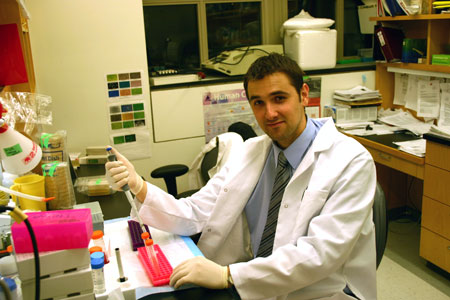
Hello from the research lab in New York
7:30 a.m. I'm first in the lab. As it's Monday, the day starts with a lab meeting where lab members present their ongoing work to each other - under the watchful eye of our leader, Dr. Rafii. Before I dash off to the meeting, I quickly check on some cell culture.
The last four weeks have been unusually crowded with work. Alongside my routine projects, I've been helping several colleagues prepare a manuscript for re-submission. We are racing against time to complete our revision. Interestingly, reviewers in several journals have not welcomed the findings we are trying to present. I might be mistaken, but in the world of science this kind of opposition usually means you are onto something.
By 1:00 p.m. the lab meeting ends, and most of us slip quietly to the basement cafeteria, or in my case, to one of the many 'street carts'. My favorite one is manned by an Egyptian. "Another chicken/lamb mix with rice and pitta bread for you?" he asks. "Yes, akhi," I respond with a nod. His food tastes great, but I believe my eating there is just a sneaky way of compensating for staying away from fast food chains.
Back in the lab. Today, I have been busy working on projects with Ilaria, a talented post-doc. I was assigned to work under her supervision from the first day. It's an exciting experience, because the projects hold tremendous potential. She's patient and diligent in her explanations, instructions and work, so I'm fortunate to be working with her. The learning curve since I arrived in September is similar to what most of us experienced after starting the Basis of Disease course in the second year - things suddenly start falling into place.
Working with fragile cell cultures and leaving them in the care of the 'womb like' incubators, I find myself drawing parallels between the life I had as a medical student and the one I’m living as a young scientist: both are grounded in dedication, patience, higher sense of responsibility and vision. Most of the inspiration that drives the thinking, as well as invention, in translational research comes directly from patients and problems relating to their care. So I believe that eventually, whether you are a scientist or a physician, your efforts should lead to improvement of patient's prospects and lives. In the words of William Osler: "He who studies medicine without books sails an uncertain sea, but he who studies medicine without patients does not go to the sea at all."

Careful analysis of results is key: Here, I'm using
confocal microscopy...
4:30 p.m. In between one of the western1 incubations, I'm asked by Sergey to do X-gal2 and H&E3 staining of certain sections. Working with him is a different kind of experience, marvelous nonetheless. Being an expert in molecular biology, he has taught me much that I didn't know, and he helped me see what I did know in a completely different way. I have cut and stained over a hundred slides up to now, so staining has become a routine. And I’ve learned to juggle assignments between the two of them, Ilaria and Sergey.
6:00 p.m. Colleagues are just getting warmed up here. I’m impressed that they stay overtime. I am also pleased that everyone takes time to answer a question or share a concern about ongoing experiments. People help each other, give advice, comment on the work, and even assist with experiments if necessary. Regardless of how exciting lab projects are, I believe it’s the people you work with who make the experience either a struggle or a pleasure. I am fortunate that all of my experience so far has been positive and stimulating. Time to go feed the cells for the day and see if anything is 'switching'.....
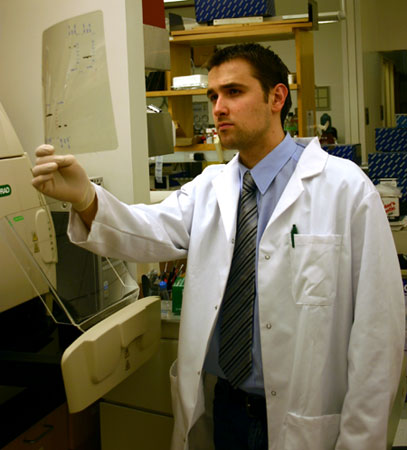
and here, interpreting the results of the western blot.
8:00 p.m. Several of us are getting ready to leave the lab. We exchange interesting stories of the day as we take the dusty elevator to the first floor. (I am looking forward to the construction ending, so we get rid of this dust). We walk out the glass doors on the 1300 entrance and say "bye" to each other. "Good night Mahmoud*," they say. As I walk back to the same 'F' train station, I put some serious effort into not getting run over by NYC taxi drivers. Taking a subway is an experience and deserves an entry in its own right: I'll leave it for some other time.
Shortly after 9 p.m. I'm home. Time to relax with Barbara Tuchman's A Distant Mirror, or maybe catch up with reading the scientific publications of the fields I'm involved in. Sometimes, I go for a run in the nearby Prospect Park, which is a nicer version of Manhattan's Central Park, created by the same landscape architect. If time allows, I would also like to see more of the "US of A" while I’m here.
Lights out. The sound of the wind in the trees outside my window helps me sink peacefully into much-needed REM.
But just before I'm there, I remember the people who helped me be here. On one side of the world, Dean Alonso supported my decision to come to the U.S., and Dr. Hammoud invested hours toward making my dream come true. On this face of the globe, Dr. Rafii generously offered me a spot in his laboratory as well as an amazing chance to learn from his brilliant work in various fields; and my hosts, Dr. Mark Pecker and his wife Betsy McGee, provided warm and generous hospitality.
To be continued...
- Western - a method of quantifying the amount of a protein of interest in a cell extract
- X-gal - is a galactoside and indole, a substance cleaved by enzyme b-galactosidase that substitutes for the expression of a gene of interest
- H&E - Hematoxylin and Eosin staining of acidic and basic cell components respectively
* One of my nicknames.
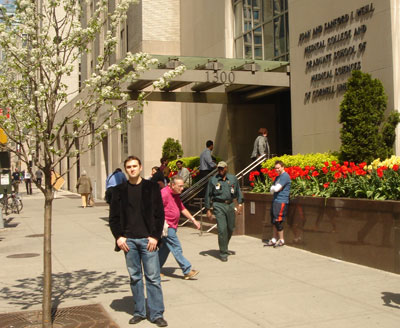
On a sunny spring day in Manhattan here I am,
just outside Weill Cornell Medical College.
Tuesday
My colleagues and I resubmitted our revised article to the Journal of Clinical Investigation - this is the manuscript I wrote about in Monday's entry. The article describes a study in which we investigated the role of cancer stem cell markers in tumor initiation. Our initial findings were very exciting but provocative as they challenged the accepted dogma of the field. The skeptical reviewers needed more compelling arguments and data, which we subsequently provided in our final version. Then we waited. We were anxious.
Now we are thrilled to hear that our paper -- CD133 expression is not restricted to stem cells and both CD133+ and CD133- cells initiate metastatic colon carcinomas -- has been accepted for publication. What a relief! Dedication, persistence, and hard work have all been rewarded.
I am privileged to be one of several co-authors: Our names are listed after that of my supervisor, Sergey, who is the lead author. We all hope our work will provide additional insights to the perplexing field of cancer stem cell biology.
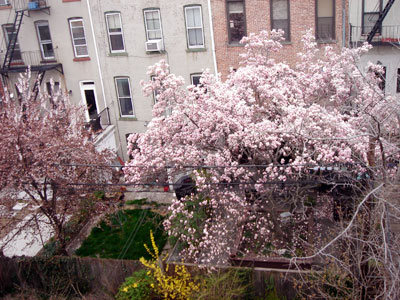
The view from my room in Brooklyn: the colors
of spring transform New York's gardens.
The news seems even sweeter because it comes at the peak of spring in New York City. Blossoms are dripping from trees throughout Brooklyn and Manhattan. In the space of just a few days, the world around us has been transformed - as are we in the lab, on learning that our article is to be published.
Traditionally, the changes of spring bring people a feeling of hope. This year, I sense the hope of spring has come to the US in other forms, notably the presidential elections still playing out across America. Fragile though it may be, I believe this hope is critical to securing a better future for all of us.
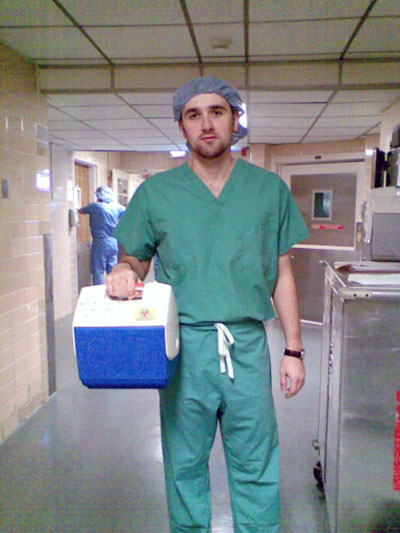
Part of our work is collaborating with
colleagues in the surgery departments
Wednesday
Understanding etiopathogenesis of a disease and disturbances of the normal human physiology that follow can best be achieved by conducting research on human specimens. Moreover, if the goal of such research is translational, than the work surely entails a close collaboration with many of the medical or surgical departments servicing health care institutions. That is exactly what we at Ansary Center for Stem Cell Therapeutics have been doing.
Recently, we have established a close collaboration with surgery departments at our own, and other Weill Cornell in New York-affiliated medical centers. Of course, since it is impossible to complement this in vitro work with equivalent in vivo human models, we work in parallel on murine*-based in vivo models as the best possible alternative.
Altogether, this provides for plenty of opportunity to meet experts from different fields as well as residents and medical students. It's a complete sense of fulfillment to be able to work with so many different people, but more importantly, integrating the languages of medical knowledge, basic science and stem cell biology towards a common goal shapes for a unit of an incredible proportion. Any inquisitive mind can hardly be left indifferent.
* murine - mouse
Thursday
An integral part of staying on top of information and trends in research fields is to actively follow various lectures, symposiums and conferences. The last lecture I went to made me recall a conference on the campus that I attended last October: the New York Stem Cell Foundation Conference 'Unlocking the Potential'. The two-day Stem Cell Foundation's Second Translational meeting took place at Rockefeller University and it gathered the world's stem cell elite. In a series of discussion panels, the audience had a chance to hear about the current stem cell progress in the fields of somatic cell nuclear transfer (SNCT), cancer, neurology, heart disease, diabetes and autoimmune disease.
However, the opening day of the conference was reserved for the public policy panel, which comprised international leaders in science, patient advocacy and bio-ethics. This was a chance to foster a dialogue on the importance of human embryonic stem cell (hESC) research, and the challenges that accompany it. It was easy to appreciate the fact that, owing to very strict federal laws governing the research on hESCs, the scientific effort has largely rested on the branches of private philanthropy, and that still remains the touchstone setting the goals and devising the agendas.
During the second day of the conference, Weill Cornell's Dr. Shahin Rafii delivered 'breaking news' highlighting the novel findings our lab published in the November issue of Nature magazine (Generation of functional multipotent adult stem cells from GPR125+ germline progenitors. 2007 Sep 20;449(7160):346-50).
Even though every presentation stirred almost an equal amount of excitement, I was particularly eager to learn about the advances pertaining to heart disease and diabetes. Representing the world’s leading cause of morbidity and mortality, pathologies stemming from these two diseases also represent the major heath problems of the people of the State of Qatar.
Altogether, I can attest that it was an incredible and humbling experience to spend a few days in the epicenter of scientific advancement. Clearly having the potential to revolutionize the way we therapeutically approach disease, stem cell research promises to draw new frontiers in translational medicine.
Friday
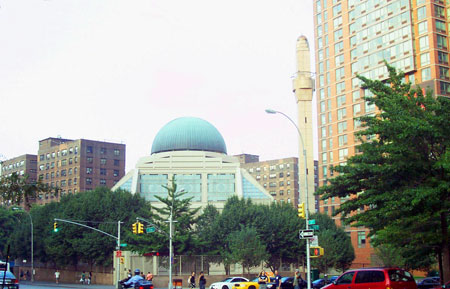
The biggest mosque in NYC, a meeting place for people from
across the world
As opposed to Doha, the last day of a working week here is Friday. It took some time getting used to thinking of Sat/Sun as the weekend days. Ultimately, it’s a little bit more convenient as it puts me more in synch with family and friends in Europe.
The end-of-the-week feel is not so much different from the Monday 'here-we-go' lifter. Work goes on as usual and, just occasionally, we may wrap up a little earlier if we want to catch a movie or a pleasant meal in one of New York's many fine restaurants. A great feature of NYC is that any cuisine you may think of is just around the corner. All it takes is an exploring spirit and a little bit of precious, free time. I have a few places in mind that I can't wait to show my friends from the Class of 2009, once they arrive to start their sub internships and electives in the summer.
Friday is also a day when I take an extended lunch beak to go for the Friday prayer, at Lex Av, 94th St. mosque. Built by benefactors from Kuwait, this mosque is the biggest in the city. What is interesting to see - and this doesn't happen much in Doha or back home in Bosnia - is the considerable number of non-Muslims attracted to the mosque. Every Friday prayer time, a few dozen of them sit and observe the khutbah* and prayer with us. In general, seeing people of so many different nationalities pray in one place strongly reminds me of the 'Gulf Pearl' I left almost a year ago.
* Friday sermonSaturday
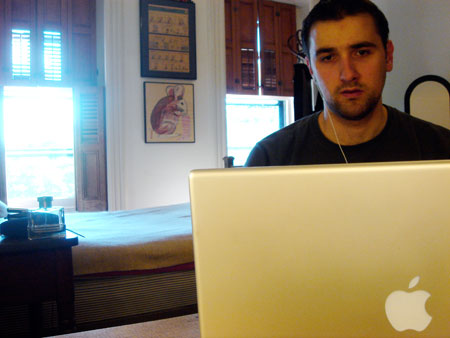
Staying in touch with family and friends
Depending on the project, weekends may or may not be free for me. If a particular manuscript needs to be submitted or if other research groups are doing the same work, I may continue working with minimal breaks. In that case, every day is like any other - the ultimate decider being personal motivation.
Oh and yes, quickly some more news on the old topic: it appears that our AC133 paper will be the cover of the June edition of the Journal of Clinical Investigation (http://jci.org/articles/view/34401)
When I do have a free weekend, I mostly try to see parts of NY and Brooklyn I have not seen before. I love playing squash so I’m always on the lookout for a new challenge. Life in general is very different here than in Qatar. Better organization of transportation and a more continental climate simply give you more options.
Taking a NY subway is something you cannot experience anywhere else. On any subway line, one is able to see people of all races and religions, speaking many languages in as many different accents, performers, dancers, singers, beggars, gay couples…. you see it all really.
Living away from home and Doha is so much easier with SKYPE! If I am not at work or in the city, this day is reserved for communicating with friends and family from Doha, Europe and US. Long live Skype!
Sunday
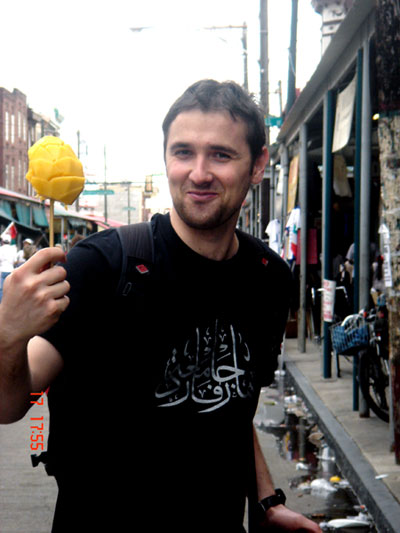
Taking time out, I hit the trail for Boston
Today, I decide to visit the city of Boston, several hours away by train. Despite never having been there, following the map and taking the appropriate trains is enough to guide me to my destination – Forest Hills on the Orange subway line. It particularly pleases me that Boston's subway system is as organized as the one in NY, providing for an easy way to go anywhere in the city. Since time is limited, my plan is to visit Harvard Square, Harvard Medical School and whatever lies in between. The weather is just perfect today and I'm really enjoying the springtime.
Harvard Square is a large triangular neighborhood in the center of Cambridge, Massachusetts. It is adjacent to the historic heart of Harvard University - Harvard Yard. The square radiates with life and it serves as a commercial center for Harvard students, as well as residents of western Cambridge and the suburbs of Boston. As I walk around, I come across a group of students representing Harvard Society of Arab Students and I buy one of their T-shirts: it has calligraphy on the front and a picture of the Harvard campus on the back.
As I make my way to the Harvard Medical School, located on the other side of the city, I receive great news by email from Doha: The paper I submitted as first author to the Qatar Medical Journal (QMJ) - "Body Packing" and its implications in Qatar - has been accepted for publication in the next issue.
Harvard Medical School is the third oldest medical college in the US. Its buildings of off-white stone form a semi-circle that opens onto the street. In the middle is the spacious yard with its meticulously trimmed English grass. Since only Harvard students and affiliates have full access to the campus, I can only take away with me a pleasant visual memory of the visit as I return to the train station for the journey back to NYC.
| © Weill Cornell Medical College in Qatar |
